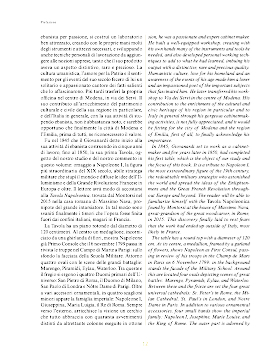Prefazione ebanista per passione, si costruì un laboratorio ben attrezzato, creando con le proprie mani molti degli strumenti e attrezzi necessari, e sviluppando anche tecniche personali di lavorazione da aggiun- gere alle nozioni apprese, tanto che il suo prodotto aveva un aspetto distintivo, raro e prezioso. La cultura umanistica, l’amore per la Patria e il senti- mento per gli eventi del suo secolo fecero di lui un solitario e appassionato cantore dei fatti salienti che lo affascinarono. Più tardi trasferì la propria of cina nel centro di Modena, in via dei Servi. Il suo contributo all’arricchimento del patrimonio culturale e civile della sua regione in particolare, e dell’Italia in generale, con la sua attività di stu- pendo ebanista, non è abbastanza noto, e sarebbe opportuno che nalmente la città di Modena e l’Emilia, prima di tutti, ne riconoscessero il valore. Fu nel 1845 che il Giovanardi dette inizio alla sua attività di ebanista costruendo in cinque anni di lavoro, no al 1850, la sua prima Tavola, og- getto del nostro studio e del nostro commento in questo volume: omaggio a Napoleone I, la gura più straordinaria del XIX secolo, abile stratega militare che stupì il mondo e diffuse le idee dell’Il- luminismo e della Grande Rivoluzione Francese in Europa e oltre. Il lettore avrà modo di accostarsi alla Tavola Napoleonica, trovata dal Montorsi nel 2015 nella casa romana di Massimo Nava, pro- nipote del grande intarsiatore. In tal modo sono svaniti nalmente i timori che l’opera fosse nita fuori dai con ni italiani, magari in Francia. La Tavola ha un piano rotondo dal diametro di 120 centimetri. Al centro un medaglione, incorni- ciato da una ghirlanda di ori, mostra Napoleone già Primo Console che il 6 novembre 1799 passa in rivista le truppe nel Campo di Marte a Parigi: sullo sfondo la facciata della Scuola Militare. Attorno quattro ovali con le scene delle grandi battaglie: Marengo, Piramidi, Eylau, Waterloo. Tra queste e il fregio si ergono i quattro Duomi primari dell’U- niverso: San Pietro di Roma, il Duomo di Milano, San Paolo di Londra e Nôtre Dame di Parigi. Oltre a vari accessori ornamentali, in quattro scaglioni minori appare la famiglia imperiale: Napoleone I, Giuseppina, Maria Luigia, il Re di Roma. Sempre verso l’esterno, arricchisce la visione un cerchio che tutto abbraccia con quaranta avvenimenti distinti da altrettante colonne eseguite in ottone sion, he was a passionate and expert cabinet maker. He built a well-equipped workshop, creating with his own hands many of the instruments and tools he needed, and also developed personal working tech- niques to add to what he had learned, imbuing his output with a distinctive, rare and precious quality. Humanistic culture, love for his homeland and an awareness of the events of his age made him a loner and an impassioned poet of the important subjects that fascinated him. He later transferred his work- shop to Via dei Servi in the centre of Modena. His contribution to the enrichment of the cultural and civic heritage of his region in particular and to Italy in general through his gorgeous cabinetmak- ing activities, is not fully appreciated, and it would be tting for the city of Modena and the region of Emilia, rst of all, to nally acknowledge his importance. In 1845, Giovanardi set to work as a cabinet- maker and ve years later in 1850, had completed his rst table, which is the object of our study and the focus of this book. It is a tribute to Napoleon I, the most extraordinary gure of the 19th century, the redoubtable military strategist who astonished the world and spread the ideas of the Enlighten- ment and the Great French Revolution through- out Europe and beyond. The reader will be able to familiarize himself with the Tavola Napoleonica found by Montorsi at the house of Massimo Nava, great-grandson of the great woodcarver, in Rome, in 2015. This discovery nally laid to rest fears that the work had ended up outside of Italy, most likely in France. The table has a round top with a diameter of 120 cm. At its centre, a medallion, framed by a garland of owers, shows Napoleon as First Consul, pass- ing in review of his troops in the Champ de Mars in Paris on 6 November 1799: in the background stands the facade of the Military School. Around this are located four ovals depicting scenes of great battles: Marengo, Pyramids, Eylau, and Waterloo. Between these and the frieze are set the four great universal cathedrals: St. Peter’s in Rome, the Mi- lan Cathedral, St. Paul’s in London, and Notre Dame in Paris. In addition to various ornamental accessories, four small bands show the imperial family: Napoleon I, Josephine, Marie Louise, and the King of Rome. The outer part is adorned by 12
